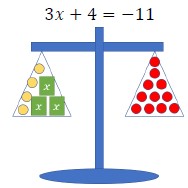Connecting Benchmarks/Horizontal Alignment
Terms from the K-12 Glossary
Vertical Alignment
Previous Benchmarks
Next Benchmarks
Purpose and Instructional Strategies
In grade 6, students are building on their ability to write and solve one-step equations with an emphasis on operations with linear expressions. In grade 7, students write and solve two-step equations. In grade 8, students solve multi-step linear equations
(MTR.5.1). - Instruction includes real-world contexts as well as linear equations where the variable may be on either side of the equal sign (MTR.7.1).
- Instruction includes students verbalizing or writing the Properties of Operations and Properties of Equality (see Appendix D) used at each step to their solution.
- Use models or manipulatives, such as algebra tiles, bar diagrams or balances, to conceptualize equations (MTR.2.1).
- Algebra Tiles
- Bar Diagrams
- Balances
- Avoid a particular order when solving and allow students to proceed in multiple ways that are mathematically accurate.
- For example, in the equation 4( + 7) = 12, students may choose to divide both sides of the equation by 4 or use the Distributive Property with the 4. Compare the various strategies and ask students to determine which will be most efficient given different problem stems (MTR.3.1).
Common Misconceptions or Errors
- Some students may incorrectly use the addition and subtraction properties of equality on the same side of the equal sign while solving an equation. To address this misconception, use manipulatives such as balances, algebra tiles or bar diagrams to show the balance between the two sides of an equation (MTR.2.1).
- Students may incorrectly identify the constants and the coefficients within a real-world context of the problem.
Strategies to Support Tiered Instruction
- Teacher provides opportunities for students to practice solving equations using the addition and subtraction properties of equality using an interactive computer equation balance, manipulatives and other visual representations.
- Teacher provides support for students in identifying the coefficients and constants within a real-world context of the problem. Present students with examples of real-world problems that can be solved with equations.
- For example, Cameron’s fish tank can hold 12 gallons of water and he adds 2.5 gallons of water a minute. If there are already 3.4 gallons of water in the tank, for how many minutes can Cameron fill his tank without overflowing?
- Teacher provides opportunities for students to comprehend the context or situation by engaging in questions (laminating these questions on a printed card for students to utilize as a resource in and out of the classroom would be helpful).
- What do you know from the problem?
- What is the problem asking you to find?
- Can you create a visual model to help you understand or see patterns in your problem?
- Teacher provides opportunities for students to use algebra tiles to co-solve provided equations with the teacher without the need of writing the equation first.
- Teacher provides opportunities for students to co-write an algebraic equation with the teacher without requiring students to solve the equation.
- Instruction includes the use of a three-read strategy. Students read the problem three different times, each with a different purpose (laminating these questions on a printed card for students to utilize as a resource in and out of the classroom would be helpful).
- First, read the problem with the purpose of answering the question: What is the problem, context, or story about?
- Second, read the problem with the purpose of answering the question: What are we trying to find out?
- Third, read the problem with the purpose of answering the question: What information is important in the problem?
- Teacher models the use manipulatives such as balances, algebra tiles or bar diagrams to show the balance between the two sides of an equation.
Instructional Tasks
Instructional Task 1 (MTR.1.1, MTR.7.1) A plumber has been called in to replace a broken kitchen sink. The material needed costs $341.25 and the total expected cost of the job is $424.09. How many hours will the plumber need to work in order to get the job completed?
- Part A. What questions would need to be answered to approach this problem? Is there enough information given to solve the problem? Why or why not?
- Part B. The average rate for a plumber in Florida is $20.71 per hour. Write and solve an equation to determine how many hours the plumber will be working.
Instructional Task 2 (MTR.5.1) The length of the rectangle is twice its width. The perimeter of the rectangle totals 45 feet. What is the width of the rectangle?
Instructional Items
Instructional Item 1What is the exact value of
in the equation
=
− 7?
Instructional Item 2 What is the value of
in the equation 5.6(
− 2) = 11?
*The strategies, tasks and items included in the B1G-M are examples and should not be considered comprehensive.



